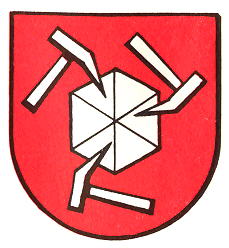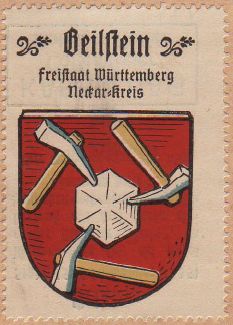Beilstein: Difference between revisions
Knorrepoes (talk | contribs) m (Text replacement - "[[Category:German Municipalities" to "50 px|link=Germany[[Category:German Municipalities") |
Knorrepoes (talk | contribs) m (Text replacement - "Category:Baden-Württemberg" to "50 pxCategory:Baden-Württemberg") |
||
| Line 26: | Line 26: | ||
[[File:Germany.jpg|50 px|link=Germany]][[Category:German Municipalities B]] | [[File:Germany.jpg|50 px|link=Germany]][[Category:German Municipalities B]] | ||
[[Category:Baden-Württemberg]] | [[File:badenwur.jpg|50 px]][[Category:Baden-Württemberg]] | ||
[[Category:Heilbronn]] | [[Category:Heilbronn]] | ||
[[Category:Granted 1930]] | [[Category:Granted 1930]] | ||
Revision as of 13:10, 9 December 2017
This page is part of the German heraldry portal Deutsche Wappensammlung |
Heraldry of the World |
|
German heraldry:
|
Selected collector's items from Germany:
|
BEILSTEIN
State : Baden-Württemberg
District (Kreis) : Heilbronn
Additions : 1971 Schmidhausen
Official blazon
In Rot ein sechseckiger silberner Stein, kreisförmig mit drei (2:1) darin eingehauenen Spitzhämmern besteckt.
Origin/meaning
The arms were granted in the present form in 1930 and are canting (Beil = axe, Stein = stone).
The oldest known seal of the city (dating from 1382) only shows a canting axe. Later seals all show an axe, sometimes accompanied from (heraldic) roses. In 1535 the arms showed three stones and three hammers, no axes anymore. From the end of the 16th century the number of stones decreased and the axes remained hammers. All later arms and seals showed three hammers and a stone, in different shapes. The colours are also known since 1535.
| The arms by Hupp in the Kaffee Hag albums +/- 1925 |
Contact and Support
Partners:
Your logo here ?
Contact us
© since 1995, Heraldry of the World, Ralf Hartemink 
Index of the site
Literature : Stadler, 1964-1971, 8 volumes.














